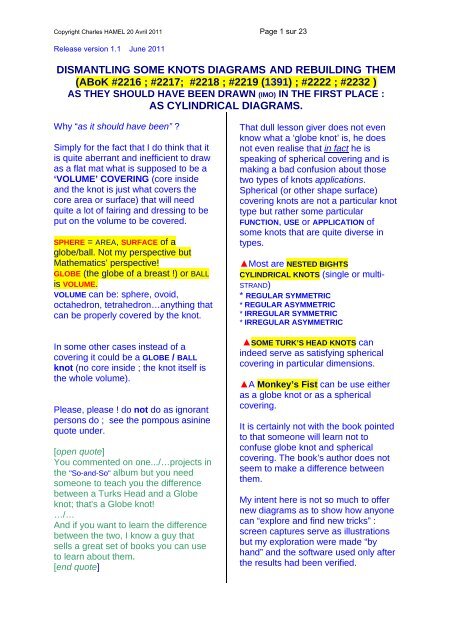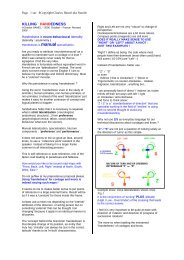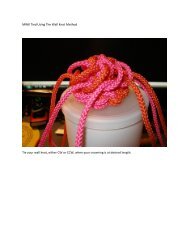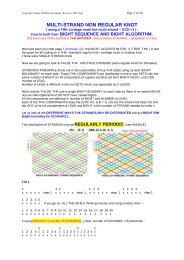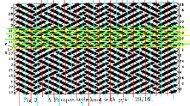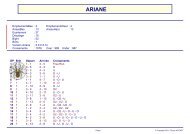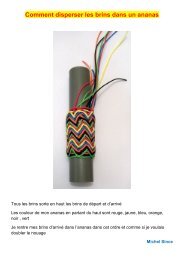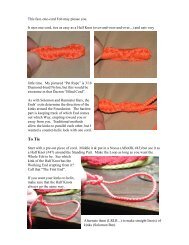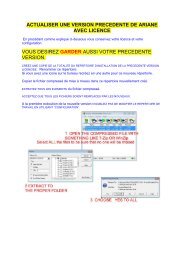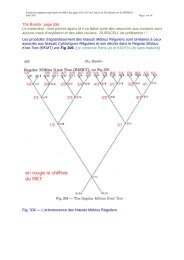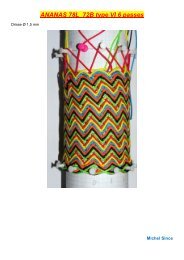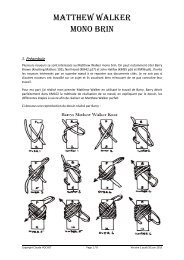23 pages Pdf - 4.92Mo - Charles HAMEL - Free
23 pages Pdf - 4.92Mo - Charles HAMEL - Free
23 pages Pdf - 4.92Mo - Charles HAMEL - Free
You also want an ePaper? Increase the reach of your titles
YUMPU automatically turns print PDFs into web optimized ePapers that Google loves.
Copyright <strong>Charles</strong> <strong>HAMEL</strong> 20 Avril 2011 Page 1 sur <strong>23</strong><br />
Release version 1.1 June 2011<br />
DISMANTLING SOME KNOTS DIAGRAMS AND REBUILDING THEM<br />
(ABoK #2216 ; #2217; #2218 ; #2219 (1391) ; #2222 ; #2<strong>23</strong>2 )<br />
AS THEY SHOULD HAVE BEEN DRAWN (IMO) IN THE FIRST PLACE :<br />
AS CYLINDRICAL DIAGRAMS.<br />
Why “as it should have been” ?<br />
Simply for the fact that I do think that it<br />
is quite aberrant and inefficient to draw<br />
as a flat mat what is supposed to be a<br />
‘VOLUME’ COVERING (core inside<br />
and the knot is just what covers the<br />
core area or surface) that will need<br />
quite a lot of fairing and dressing to be<br />
put on the volume to be covered.<br />
SPHERE = AREA, SURFACE of a<br />
globe/ball. Not my perspective but<br />
Mathematics’ perspective!<br />
GLOBE (the globe of a breast !) or BALL<br />
is VOLUME.<br />
VOLUME can be: sphere, ovoid,<br />
octahedron, tetrahedron…anything that<br />
can be properly covered by the knot.<br />
In some other cases instead of a<br />
covering it could be a GLOBE / BALL<br />
knot (no core inside ; the knot itself is<br />
the whole volume).<br />
Please, please ! do not do as ignorant<br />
persons do ; see the pompous asinine<br />
quote under.<br />
[open quote]<br />
You commented on one.../…projects in<br />
the "So-and-So" album but you need<br />
someone to teach you the difference<br />
between a Turks Head and a Globe<br />
knot; that's a Globe knot!<br />
…/…<br />
And if you want to learn the difference<br />
between the two, I know a guy that<br />
sells a great set of books you can use<br />
to learn about them.<br />
[end quote]<br />
That dull lesson giver does not even<br />
know what a ‘globe knot’ is, he does<br />
not even realise that in fact he is<br />
speaking of spherical covering and is<br />
making a bad confusion about those<br />
two types of knots applications.<br />
Spherical (or other shape surface)<br />
covering knots are not a particular knot<br />
type but rather some particular<br />
FUNCTION, USE or APPLICATION of<br />
some knots that are quite diverse in<br />
types.<br />
▲Most are NESTED BIGHTS<br />
CYLINDRICAL KNOTS (single or multi-<br />
STRAND)<br />
* REGULAR SYMMETRIC<br />
* REGULAR ASYMMETRIC<br />
* IRREGULAR SYMMETRIC<br />
* IRREGULAR ASYMMETRIC<br />
▲SOME TURK’S HEAD KNOTS can<br />
indeed serve as satisfying spherical<br />
covering in particular dimensions.<br />
▲A Monkey’s Fist can be use either<br />
as a globe knot or as a spherical<br />
covering.<br />
It is certainly not with the book pointed<br />
to that someone will learn not to<br />
confuse globe knot and spherical<br />
covering. The book’s author does not<br />
seem to make a difference between<br />
them.<br />
My intent here is not so much to offer<br />
new diagrams as to show how anyone<br />
can “explore and find new tricks” :<br />
screen captures serve as illustrations<br />
but my exploration were made “by<br />
hand” and the software used only after<br />
the results had been verified.
Copyright <strong>Charles</strong> <strong>HAMEL</strong> 20 Avril 2011 Page 2 sur <strong>23</strong><br />
Release version 1.1 June 2011<br />
Lets us state some points.<br />
*** Most often the cylindrical diagram is<br />
easy to deduce once the coloured<br />
markers are in place, that despite the<br />
aberrant clockwise move that is shown<br />
on some of the flat diagrams that on a<br />
vertical cylinder translates into the<br />
aberrant BOTTOM-LEFT to TOP-RIGHT for<br />
ODD numbered HALF-PERIODS.<br />
( to know the meaning I attached to<br />
‘aberrant’ please read page 7 and<br />
beginning of page 8 of my .pdf on Pins<br />
notation at<br />
http:/charles.hamel.free.fr/knots-andcordages/PUBLICATIONS/KnotNotatio<br />
n-V1.pdf<br />
This aberration is corrected in all but<br />
one of the cylindrical diagrams and<br />
ODD numbered Half-Periods go from<br />
BOTTOM- RIGHT to TOP LEFT.<br />
*** I also dispense with what is, in my<br />
opinion at least, a formidably inefficient<br />
way of indicating the nature of the<br />
crossings which is more hinder than<br />
help for the knot-tyer and may have<br />
some usefulness only if used with a<br />
cord laid on a printed diagram.<br />
Ashley went for ‘proprietary<br />
formulation’ alas his utterly bizarre<br />
crossing ‘cryptography” :<br />
- is cumbersome, more hinder<br />
than help for the knot tyer<br />
- is quite error prone<br />
- does not allow the immediate<br />
perception of the “PATTERN”<br />
made by the crossings.<br />
All in all “ a work not really done and<br />
certainly not to be done” ( ni fait, ni à<br />
faire as goes the French expression to<br />
qualify a somewhat less than ideal job)<br />
A parté : immediate rejection without a carefully and<br />
honest open-mind critical evaluation (as for<br />
academic works) is bad but I do wonder for sure if<br />
parroted and medullar ( automated, by-passing the<br />
brain higher structures and functions) praise and<br />
admiration without same examination is not worse.<br />
Ashley’s work is a tremendous effort, irreplaceable,<br />
but is far from lacking in sore points !<br />
We begin with a “shock” treatment<br />
using #2218 first.<br />
After that first dive in cold water we<br />
take a more reasonable learning<br />
gradient : #2216, #2222, #2217,<br />
#2219 (#1391), #2<strong>23</strong>2<br />
Readers who prefer to<br />
avoid any possibility of<br />
brain sprain will best go<br />
directly to #2216, read<br />
till they are finished with<br />
#2217 then go back to<br />
#2218 and finish with<br />
#2219 , #2<strong>23</strong>2.
Copyright <strong>Charles</strong> <strong>HAMEL</strong> 20 Avril 2011 Page 3 sur <strong>23</strong><br />
Release version 1.1 June 2011<br />
ABoK #2218 DISSECTION :<br />
Fig 1<br />
Fig 2<br />
Fig 3 Fig 4<br />
But is that a reality perceived or just wishful thinking ?<br />
Lets us dispense with the way of indicating the nature of the<br />
crossings which is more hinder than help. (Fig 2 )<br />
A first glance immediately shows an intimation of possible<br />
SYMETRIC REGULAR NESTED-BIGHTS CYLINDRICAL<br />
KNOT, 4 BIGHTS-NESTS , 2 BIGHTS-PER NEST,<br />
8 LEADS, x=6<br />
A first quickly made grid, using ARIANE the Claude HOCHET’s program that makes grids<br />
of Nested-Bight Cylindrical Knots, shows that 2 STRANDS are needed to make such a knot<br />
with a 4 BIGHTS-NESTS, 2 BIGHTS per NEST, distance x = 6 and 48 CROSSINGS. Fig 5.
Copyright <strong>Charles</strong> <strong>HAMEL</strong> 20 Avril 2011 Page 4 sur <strong>23</strong><br />
Release version 1.1 June 2011<br />
It is not so much the 48 CROSSINGS that<br />
make it “no go” than the 2-STRANDs.<br />
A PINEAPPLE BUT NOT A STANDARD<br />
HERRINGBONE-PINEAPPLE !<br />
Fig 6<br />
Fig 5<br />
The first point to solve, if we<br />
are to succeed in our making<br />
of a cylindrical diagram, is<br />
that the need of two STRANDS<br />
must be nullified and<br />
transformed to single<br />
strand-ness so to speak ; the<br />
2 strands must be reunited by<br />
making the route of one<br />
flows into the route of the<br />
other .
Copyright <strong>Charles</strong> <strong>HAMEL</strong> 20 Avril 2011 Page 5 sur <strong>23</strong><br />
Release version 1.1 June 2011<br />
Fig 8 Fig 7<br />
Fig 9<br />
There is something that we must<br />
examine (and do) in the bottom right<br />
hand corner of Fig 7<br />
Fig 10<br />
Fig 9 is equivalent to Fig 10 but is much<br />
more efficient for spherical covering<br />
practical tying.<br />
Remains to see if Fig 11 and Fig 12<br />
are equivalent to Fig 8 .
Copyright <strong>Charles</strong> <strong>HAMEL</strong> 20 Avril 2011 Page 6 sur <strong>23</strong><br />
Release version 1.1 June 2011<br />
Fig 11 Fig 12<br />
Obviously the answer is NO. None is equivalent to Fig 10. So better leave that trail that was<br />
looking for a simplification by re-entering.<br />
In Fig 12 (Fig 14) ? is a newly created crossing and ?? stands for crossing #<strong>23</strong> GHOST !<br />
It has 47 FACEs instead of 48 but it may (though I doubt it) be worth a try as for some<br />
ASYMETRIC IRREGULAR NESTED-BIGHTS CYLINDRICAL KNOTS.<br />
Fig 13 Fig 14<br />
FiG 13 is the correct cylindrical diagram to use.
Copyright <strong>Charles</strong> <strong>HAMEL</strong> 20 Avril 2011 Page 7 sur <strong>23</strong><br />
Release version 1.1 June 2011<br />
ABoK #2216<br />
Fig 1<br />
Fig 2 Fig 3<br />
In the first second of looking at that<br />
diagram it is evident that this is a REGULAR<br />
SYMMETRIC NESTED-BIGHT CYLINDRICAL<br />
KNOT drawn in an absurd flat form.<br />
It is quite easy, once the coloured PINs are<br />
in place, to transform it into a cylindrical<br />
diagram.<br />
Fig 4
Copyright <strong>Charles</strong> <strong>HAMEL</strong> 20 Avril 2011 Page 8 sur <strong>23</strong><br />
Release version 1.1 June 2011<br />
Fig 5<br />
Fig 6<br />
Fig 6 shows a grid of a 4 BIGHTS-NESTS, 2 BIGHTS per NEST, 24 FACES, 5 LEADS, x=3 so it<br />
is “just like” #2216. NO! not at all.<br />
We have to comply with a correct OFFSET between the TOP and BOTTOM BIGHTS-NESTS.
Copyright <strong>Charles</strong> <strong>HAMEL</strong> 20 Avril 2011 Page 9 sur <strong>23</strong><br />
Release version 1.1 June 2011<br />
Fig 7 shows the correction to be made<br />
Fig 8<br />
Fig 8 shows the cylindrical diagram that is, by and large, a lot more helpful and descriptive<br />
for any knot tyer than the cumbersome flat diagram made by ASHLEY.<br />
The flat form is uneasy to use and also deforms the knot so much that it will need a lot more<br />
adjusting and dressing to be put on a ball that the one coming off of a cylinder.
Copyright <strong>Charles</strong> <strong>HAMEL</strong> 20 Avril 2011 Page 10 sur <strong>23</strong><br />
Release version 1.1 June 2011<br />
ABoK #2222<br />
FIG 1<br />
FIG 2 FIG 3<br />
Note that there are SIX BIGHTs on one KNOT EDGE and THREE BIGHTs on the other KNOT<br />
EDGE== ASYMMETRIC<br />
As there are NESTED-BIGHTs on one KNOT EDGE this leads to ASYMMETRIC NESTED<br />
BIGHTS CYLINDRICAL KNOT.<br />
Putting in the PINs makes things clear and the obvious use of “usual” crossing (rather than<br />
the queer Ashley’s crossings) offers the knot-tyer a better and more immediate ‘visual<br />
acquisition’ of the PATTERN.
Copyright <strong>Charles</strong> <strong>HAMEL</strong> 20 Avril 2011 Page 11 sur <strong>23</strong><br />
Release version 1.1 June 2011<br />
FIG 4 FIG 5<br />
FIG 6<br />
It is easy with the use of<br />
colours to verify the<br />
congruence of the crossings of<br />
FIG 5 and FIG 6
Copyright <strong>Charles</strong> <strong>HAMEL</strong> 20 Avril 2011 Page 12 sur <strong>23</strong><br />
Release version 1.1 June 2011<br />
ABoK #2217<br />
Fig 1<br />
Another example of aberrant drawing under a flat mat form of what would have been better<br />
made under the form of a cylinder diagram because (quite evident to see) this is a<br />
SYMMETRIC REGULAR NESTED-BIGHTS CYLINDRICAL KNOTS. 40 FACEs<br />
4 BIGHT-NESTS, 2 NESTS per BIGHT, just as #2216 but while x=3 for #2216 here x=5 and that<br />
makes a difference.<br />
Fig 2<br />
This isometric cylindrical diagram is easy to deduce once the coloured markers are in place.
Copyright <strong>Charles</strong> <strong>HAMEL</strong> 20 Avril 2011 Page 13 sur <strong>23</strong><br />
Release version 1.1 June 2011<br />
Fig 3<br />
Fig 4<br />
The two coding O1-U1 (U1-O1) that can be applied.<br />
This #2217 is full of lessons
Copyright <strong>Charles</strong> <strong>HAMEL</strong> 20 Avril 2011 Page 14 sur <strong>23</strong><br />
Release version 1.1 June 2011<br />
Fig 5<br />
Fig 5 is #2217 with O2-U2 ( or vice<br />
versa ) applied == herringbone PATTERN<br />
(NOT, repeat NOT, herringbone KNOT - a<br />
STANDARD HERRINGBONE KNOT DOES<br />
NOT HAVE ANY NESTED-BIGHTS, despite<br />
what some person considered by himself<br />
and his friends as an “ex-spurt” put on his<br />
web <strong>pages</strong>. STANDARD HERRINGBONE<br />
KNOTS have all their BIGHTs along a unique<br />
BIGHT RIM on each KNOT EDGE so it is<br />
absolutely impossible to have NESTED-<br />
BIGHTS.)<br />
Fig 6 is a simili- #2217 WITH ONE SLIGHT MODIFICATION x=7 instead of x=5 ( 56 FACEs )<br />
It can also take the O2-U2 and get a<br />
Herringbone PATTERN as it is easy to<br />
verify (this suppleness of exploration is<br />
one of the great advantage of ARIANE,<br />
Claude HOCHET’s program for NESTED-<br />
BIGHTS CYLINDRICAL KNOTS.)<br />
Fig 6
Copyright <strong>Charles</strong> <strong>HAMEL</strong> 20 Avril 2011 Page 15 sur <strong>23</strong><br />
Release version 1.1 June 2011<br />
ABoK #2219<br />
FIG 1<br />
FIG 2 FIG 3<br />
Fig 2 shows the crossings in place and Fig 3<br />
shows, between the “wasp” crossings, the<br />
aberrant points in the O1-U1 pattern as N° 38<br />
and N°37 crossings are U1-U1 and NOT U1-O1<br />
or O1-U1.
Copyright <strong>Charles</strong> <strong>HAMEL</strong> 20 Avril 2011 Page 16 sur <strong>23</strong><br />
Release version 1.1 June 2011<br />
FIG 4<br />
FIG 4 is the only way to obtain a ‘real’ symmetric<br />
nested-bights cylindrical knot with 4 BIGHTS-<br />
NESTS , 2 BIGHTS per NEST, x=10.<br />
Unfortunately for our purpose it is TWO-STRAND so<br />
we will need a trick to make it 1-STRAND.<br />
FIG 5<br />
shows the<br />
trick used to<br />
make one<br />
strand route<br />
flow into the<br />
other strand<br />
route.<br />
FIG 5 BIS<br />
FIG 5<br />
The<br />
orientation of winding in the cylindrical diagram is<br />
aberrant so we would need some geometrical<br />
manipulation to make it<br />
“normal” as in FIG 5 BIS<br />
in which ODD numbered HALF-PERIODS go from<br />
BOTTOM-RIGHT to TOP-LEFT<br />
Hopefully every reader will have noted that to get the<br />
correct orientation the INNER KNOT EDGE is put at<br />
the TOP and the OUTER KNOT EDGE at the<br />
BOTTOM.<br />
Plus the colours that read clockwise on FIG 7 are (in<br />
circular order)<br />
Yellow – Dark beige – Orange – Yellow and Dark violet – Mauve rose – Dark red – Blue<br />
are to be put IN THAT ORDER BUT WRITING RIGHT to LEFT. Or write them LEFT to RIGHT but<br />
READ THEM ANTI-CLOCKWISE (this must reminds you of Schaake’s Bights Algorithm. NO?)
Copyright <strong>Charles</strong> <strong>HAMEL</strong> 20 Avril 2011 Page 17 sur <strong>23</strong><br />
Release version 1.1 June 2011<br />
FIG 7<br />
FIG 6<br />
Let us, as a « lesson » and mental (s)training,<br />
continue with the aberrant orientation.
Copyright <strong>Charles</strong> <strong>HAMEL</strong> 20 Avril 2011 Page 18 sur <strong>23</strong><br />
Release version 1.1 June 2011<br />
FIG 8 FIG 9<br />
FIG 9 is the way Ashley put the crossings.<br />
Following is the “making of” of ABoK #1391 as a practical example for training purpose.
Copyright <strong>Charles</strong> <strong>HAMEL</strong> 20 Avril 2011 Page 19 sur <strong>23</strong><br />
Release version 1.1 June 2011<br />
THE MAKING OF OF ABoK 1391 as PRACTICAL STEP BY STEP EXAMPLE<br />
FIG 1<br />
By calling this knot a TURK’s HEAD, ASHLEY shows, as alas in other instances, a<br />
staggering lack of efficient observation, depth of structured analyse and knowledge.<br />
He was just “following what I was told by tradition”, thoughtlessly, inattentively, without any of<br />
the critical spirit of the trained explorer.<br />
This knot has absolutely nothing in common with a THK as defined by perfectly known ( for<br />
many centuries) cycloids equations. See my features on the mathematics of THK.<br />
It is a SYMMETRIC NESTED-BIGHTS CYLINDRICAL KNOT light years from looking like<br />
any Regular Knots Row and Column coded O1-U1 known as THK.<br />
FIG 2
Copyright <strong>Charles</strong> <strong>HAMEL</strong> 20 Avril 2011 Page 20 sur <strong>23</strong><br />
Release version 1.1 June 2011<br />
Make a hand drawing, rough sketching is quite all right, mark the PINs and crossings, make a<br />
rough diagram under it and explore the HALF-PERIODS. Verify and finalise.<br />
FIG 3<br />
Make a neater diagram using an isometric graph paper.<br />
FIG 4<br />
If you are lucky enough to have a<br />
licensed copy then explore with<br />
ARIANE.
Copyright <strong>Charles</strong> <strong>HAMEL</strong> 20 Avril 2011 Page 21 sur <strong>23</strong><br />
Release version 1.1 June 2011<br />
ABoK #2<strong>23</strong>2<br />
FIG 1<br />
FIG 2<br />
FIG 3
Copyright <strong>Charles</strong> <strong>HAMEL</strong> 20 Avril 2011 Page 22 sur <strong>23</strong><br />
Release version 1.1 June 2011<br />
FIG 4<br />
FIG 5
Copyright <strong>Charles</strong> <strong>HAMEL</strong> 20 Avril 2011 Page <strong>23</strong> sur <strong>23</strong><br />
Release version 1.1 June 2011<br />
FIG 6 A TWO-STRAND IMITATION OF THE #2<strong>23</strong>2 = A STANDARD HERRINGBONE-<br />
PINEAPPLE - ONE SET of component THK is empty the other SET contains 2 THK 3L 4B<br />
FIG 8 Still you can use just O1-U1<br />
FIG 7


